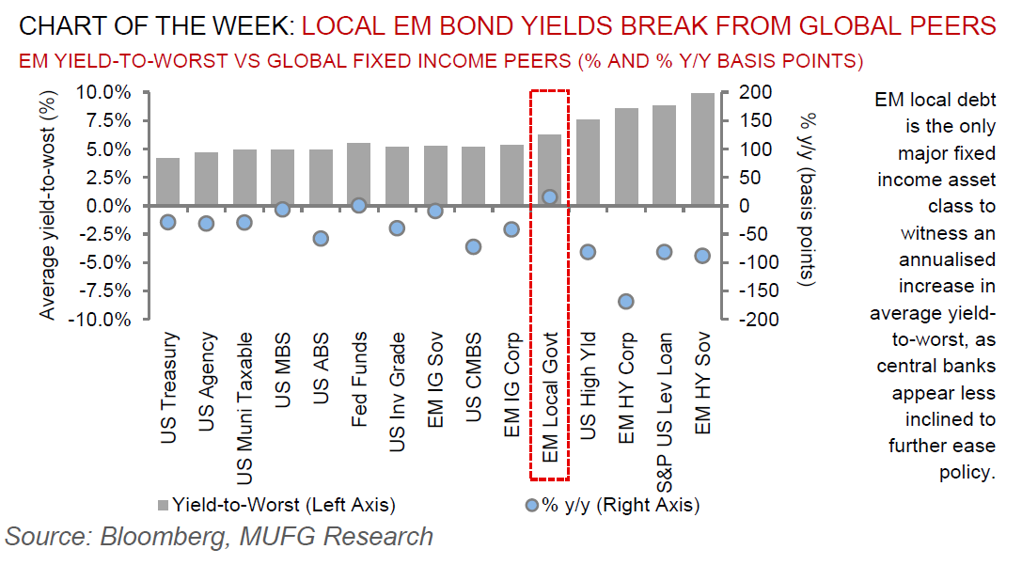To read the full report, please download the PDF above.
Has the recession already begun?
EHSAN KHOMAN
Head of Commodities, ESG and
Emerging Markets Research –
EMEA
DIFC Branch – Dubai
T:+971 (4)387 5033
E: ehsan.khoman@ae.mufg.jp
SOOJIN KIM
Research Analyst
DIFC Branch – Dubai
T: +44(4)387 5031
E: soojin.kim@uk.mufg.jp
LEE HARDMAN
Senior Currency Analyst
Global Markets Research
Global Markets Division for EMEA
T: +44(0)20 577 1968
E: lee.hardman@uk.mufg.jp
MUFG Bank, Ltd.
A member of MUFG, a global financial group
Macro focus
It's too early to say for certain, but the rise in the US unemployment rate to all-but-trigger the Sahm rule and the plunge in ISM manufacturing could be the first signs of a sustained cyclical contraction in the US economy. Markets are still trading under the influence of two opposing forces – the beginning of the Fed easing cycle (with the focus seemingly shifting from inflation towards unemployment), and the general market reverberations of a potential second Trump presidency. As the US election gradually moves front of mind, consensus expectations are that the broader US dollar may gain more territory and the US back-end may find renewed upward pressure. Should this materialise, EM rates, bonds and currencies will increasingly feel the heat.
FX views
It has been a volatile week for emerging market currencies. The Asian currencies of the MYR (+4.8% vs. USD), THB (+2.4%), and CNY (+2.0%) have been the top performing currencies. In contrast, the Latam currencies of the MXN (-5.7% vs. USD), BRL (-2.0%) and COP (-1.6%) have been the worst performing currencies. The price action has been mainly driven by ongoing position adjustment triggered by the sharp unwinding of JPY-funded carry trades. If US/global growth slowdown fears intensify further it could trigger broader sell-off for EM FX and stronger USD.
Week in review
Hungary’s economy contracted in Q2 2024 (flash estimate with no expenditure breakdown of GDP). Inflation in Poland edged higher in July on higher electricity and gas prices, delaying potential monetary easing until at least next year. The Czech Republic slowed its easing pace (-25bps to 4.50%) but raised it repo rate projections (from 3.0% to 3.5%). The IMF Board completed the third review of the Extended Fund Facility (EFF) programme after an SLA was reached in June – allowing Egypt to draw USD820m. Qatar’s fiscal surplus reached USD714m (1.4% of quarterly GDP) in Q2 2024. Finally, flash readings signalled that Saudi Arabia’s GDP expanded by 1.4% q/q in seasonally adjusted terms in Q2 2024, maintaining the robust pace of sequential expansion recorded in final data for the first quarter.
Week ahead
This week, there will be an MPC meeting in Romania (MUFG and consensus: on hold to 6.75%). July inflation data will be released in Egypt (MUFG: 25.9% y/y; no consensus), Hungary (MUFG: 3.9% y/y; consensus: 4.0% y/y) and Russia (MUFG and consensus: up 0.5ppts to 9.1% y/y). Finally, Q2 2024 GDP data will be made available in Russia (MUFG: 5.1% y/y; consensus: 4.2% y/y).
Forecasts at a glance
Growth across the EM universe is set to stabilise as domestic fundamentals offset external drags, with some rotation from the largest to smaller EMs. Inflation and interest rates are both “over the hump” – disinflation is progressing, and the decline in rates will continue and broaden in 2024.
Core indicators
The latest weekly IIF flow data signalled that EM securities attracted USD0.2bn in the week ending 26 July. The breakdown suggests that equities (USD-0.4bn) were offset by debt (USD0.2bn) over the week.


